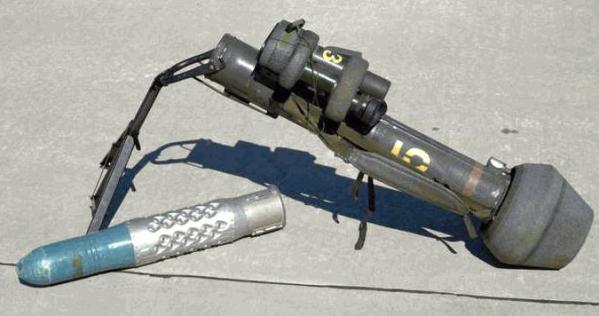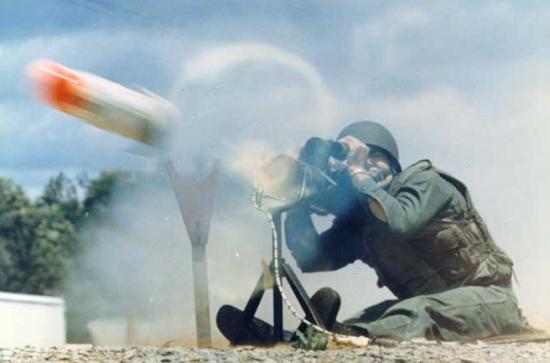McDonnell Douglas FGM-77 Dragon
The FGM-77 Dragon was the first man-portable anti-tank guided missile deployed by the U.S. Army and U.S. Marine Corps. It was retired during the late 1990s, and replaced by the FGM-148 Javelin.
In the early 1960s, the U.S. Army established the MAW (Medium Anti-Tank/Assault Weapon) program based on a proposal by Douglas. In 1964/65, the U.S. Army evaluated the design and guidance concept for the MAW missile, and in February 1966, McDonnell Douglas was awarded a development contract for the MAW. The MAW system was designated as Weapon System, Anti-Tank, XM47. In 1967, the designations XFGM-77A and XFTM-77A were allocated to the projected tactical and training variants of the missile, and the name Dragon was assigned. The first guided test flight of an XFGM-77A succeeded in December 1967, and in July 1968, the first guided shot from the portable launcher occurred. During 1970/71, a thermal imaging night sight was developed for Dragon. In March 1972, the first production contract for Dragon was awarded, and in February 1973, the Dragon was classified as standard equipment. The latter action changed the designation of the weapon system to M47, and those of the tactical and training rounds to FGM-77A and FTM-77A, respectively. In January 1975, the Dragon missiles were first delivered to operational Army and Marine Corps units. Missile production was subsequently shared between McDonnell Douglas and Raytheon.
 |
| Photo: DOD |
| FGM-77A |
The FGM-77A missile rounds were delivered to the troops complete with the expendable launchers. The operator attached the reusable Kollsman SU-36/P optical/IR sighting and tracking unit to the launch tube, and then acquired a target in the telescopic sight. After the missile was launched from the closed tube by a solid-fuel ejection charge, the operator had to keep the cross-hairs in his sight on target. The tracking and control unit would then sent corrective commands through the guidance wire, which was spooled out from the back of the missile. The Dragon missile was stabilized in flight by three flip-out tail fins, and controlled by multiple pairs of small rocket motors on the side of the fuselage. The maximum range of 1000 m (3300 ft) was determined by the length of the wire. The 2.45 kg (5.4 lb) linear shaped charge warhead detonated on impact, and could defeat up to 600 mm of armour. The carrying weight of a missile round, including the launcher but not the tracker, was about 15 kg (33 lb).
 |
| Photo: U.S. Army |
| FGM-77A |
In 1986, the USMC initiated the Dragon PIP (Product Improvement Program), to extend the useful service life of the missile. The U.S. Army did not participate in the PIP. The first step was the Dragon II, which has a new warhead designed to penetrate more modern types of armour. Beginning in 1988, all FGM-77A rounds of the USMC were converted to the new warhead. Some sources quote the designation FGM-77B for the Dragon II, but this may be unofficial. The second phase of the PIP, called Dragon III, was to be a missile with increased range (1500 m (4900 ft)), and an extendable nose probe with a precursor warhead to defeat reactive armour. However, the Dragon III program was cancelled in 1989.
The Dragon missile system was used by the U.S. Army and Marine Corps during Operation Desert Storm in 1991. However, the missile was essentially obsolete then, and the drawbacks, including no protection for the operator and inability to defeat the most modern armour, became all too obvious.
Production of the Dragon missiles was completed in 1981, after more than 200000 rounds had been built, including about 100000 for export. In 1997, CMS Inc. of Tampa, FL, purchased all rights on the Dragon system from McDonnell Douglas. The Dragon was phased out from 1996 on, being replaced by the FGM-148 Javelin missile. It is possible that there is still a residual stock of Dragon systems in the Army and/or Marine Corps inventory.
Specifications
Note: Data given by several sources show slight variations. Figures given below may therefore be inaccurate!
Data for FGM-77A/B:
| FGM-77A | FGM-77B | |
|---|---|---|
| Length | 74.4 cm (29.3 in) | 84.6 cm (33.3 in) |
| Finspan | 34 cm (13.4 in) | |
| Diameter | 25 cm (9.8 in) | |
| Weight | 10.9 kg (24 lb) | 12.2 kg (27.1 lb) |
| Speed | 90 m/s (300 fps) | |
| Range | 1000 m (3300 ft) | |
| Propulsion | Array of small solid-fueled rocket motors; 1.2 kN (265 lb) each | |
| Warhead | 2.5 kg (5.5 lb) shaped charge | |
Main Sources
[1] Bill Gunston: "The Illustrated Encyclopedia of Rockets and Missiles", Salamander Books Ltd, 1979
[2] Hajime Ozu: "Missile 2000 - Reference Guide to World Missile Systems", Shinkigensha, 2000
[3] R.T. Pretty, D.H.R. Archer (eds.): "Jane's Weapon Systems 1972-73", Jane's, 1973
[4] Bernard Blake (ed.): "Jane's Weapon Systems 1987-88", Jane's, 1988
[5] Redstone Arsenal Historical Information Website
Back to Current Designations Of U.S. Unmanned Military Aerospace Vehicles
Back to Directory of U.S. Military Rockets and Missiles
Last Updated: 7 June 2002